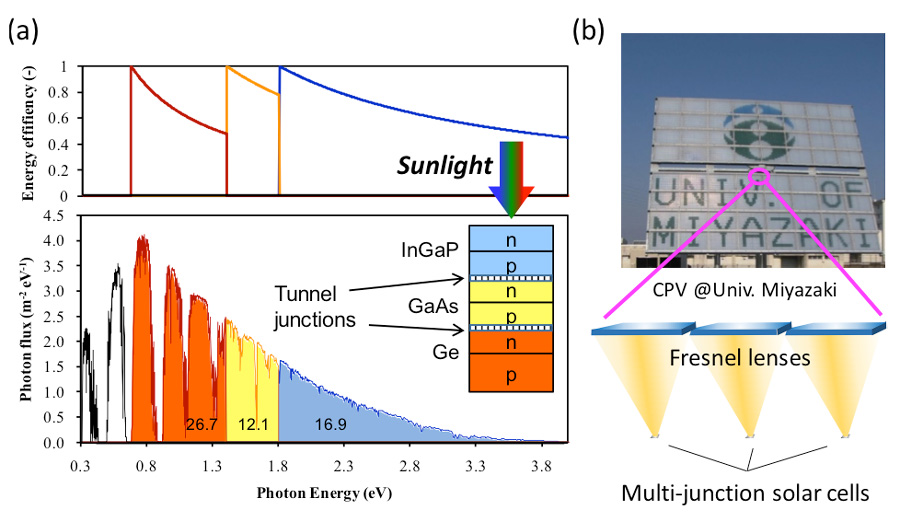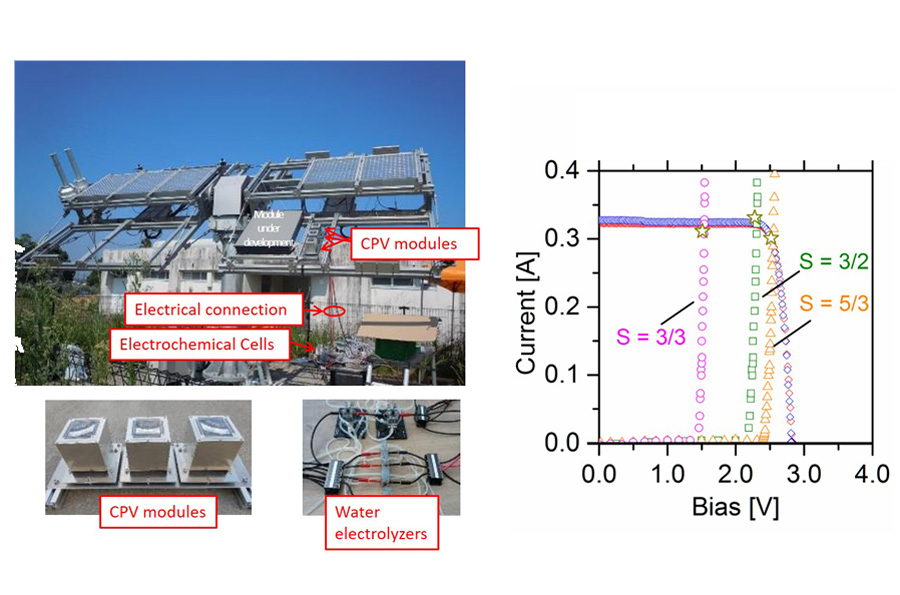■ Example of research topics ■
[ Solar ]
1. 4 junction by wafer bonding /
2. High-speed MOVPE /
3. EL and PL characterization /
4. Thin-film multi-junction (design and light trapping) /
5. 1.15 eV middle cell with MQWs /
6. Theoretical modeling of MQWs (quasi bulk approach and cell design) /
7. WoW /
8. ELO /
9. Dilute nitride MQW
[ Growth ]
1. III-V on Si photo detector /
2. III-V on Si solar cell
[ LED ]
1. Chip-white LED
[ Solar Fuel ]
1. CPV + water electrolysis /
2. CO2 reduction /
3. Semiconductor/electrolyte interface /
4. Polarization-controlled nitride photocathode /
5. Design of energy management system using hydrogen-based power storage
[ Quantum Modeling ]
1. Quantum modeling of insulators
High efficiency solar hydrogen production combining concentrator photovoltaic modules and water electrolyzers
Daiji Yamashita, Katsushi Fujii (RIKEN), Yoshiaki Nakano, Kensuke Nishioka (Miyazaki Univ.) and Masakazu Sugiyama
Hydrogen could potentially provide a readily-available, clean form of energy derived from solar power. To achieve this, scientists need to find a highly-efficient, low-cost way of splitting water into its constituent parts of oxygen and hydrogen using the energy from the sun. We have found a way to produce hydrogen at the highest efficiency yet, using a combination of concentrator photovoltaic (CPV) modules and water electrolyzers.
CPV technology generates electricity by using mirrors or lenses to focus an intense beam of sunlight onto tiny but highly-efficient solar cells. The researchers used the most efficient CPV modules currently available, with an efficiency of around 31%. They used a InGaP/GaAs/Ge three-junction solar cell at the sunlight focus point inside the CPV. The electrolyzers, which provide the means for splitting water, were then connected in series to the CPV modules using copper wires.
We placed the combined device outdoors, and fed pure water into the electrolyzer. We found that their device was able to produce hydrogen at an efficiency of 24.4% - the highest level of solar-to-hydrogen efficiency yet achieved. The highest energy transfer efficiency necessitates voltage matching between CPV modules and electrolyzers so that CPV modules can function at the maximum efficiency point.
In order to keep voltage matching under the variation of sunlight irradiation intensity, we need to insert a DC/DC voltage converter in between CPVs and electrolyzers. A benchmark plant for continuous production of solar hydrogen on the basis of this design concept is introduced in Miyazaki University. We will demonstrate the effectiveness of continuous high-efficiency solar hydrogen production and clarify major issues in preparation for industrial applications.

Fig. 1 Schematic operation principle of a concentrator photovoltaic module (CPV) using multi-junction cells

Fig. 2 (left) Field demonstration equipment of high-efficiency solar hydrogen production combining CPV and water electrolyzers at Miyazaki University. (right) A concept of operation-voltage matching.